Final report for FNE18-906
Project Information
The objective of this research project was to determine if regionally adapted (RA) entomopathogenic nematode EPN strains and Bti will provide efficacy for swede midge (SM) and to determine whether one of these controls works better than the other or if they will need to be applied together.
If we determine that these controls are effective, it will provide economic benefit to farmers who have experienced crop loss due to swede midge damage and mitigate the spread of these insects to unaffected regions.
in 2018 100 Brussel sprout plants were planted in two 250 foot rows. 10 plants were planted in 20-foot sections with 10 feet between each section. Each section was marked off by a different colored flag. Two types of regionally adapted (RA) entomopathogenic nematodes (EPNs), S. feltiae, and H. bacteriophorasoil were applied randomly to the the test sections. Two traps where set up in the field to trap swede midge. Once the midge was detected, the test section would be covered with proteckNet and Bti would be applied randomly to sections of the test area.
In 2018 there was no evidence of swede midge in the traps so Bti was not applied. In 2019, because of the wet spring and early summer, the test plants were planted too late -past the time the swede midge usually flies. For this reason the study was not able to be carried out in 2019. The evidence was inconclusive for both years. Additionally, there was no proven damage to the crops from swede midge. Though some plants had some odd growth habits that can be contributed to swede midge, there are other factors that can also lead to these odd growth habits such as dear, rabbit or looper damage. The damage was very minimal.
Thus, we could not answer the question and did not meet our objectives due to lack of pest pressure during the study years.
The purpose of this project was to help find an effective organic control for SM.
The objective of this research project is to determine if regionally adapted (RA) entomopathogenic nematode EPN strains and Bti will provide efficacy for swede midge (SM) and to determine whether one of these controls works better than the other or if they will need to be applied together.
If we determine that these controls are effective, it will provide economic benefit to farmers who have experienced crop loss due to swede midge damage and mitigate the spread of these insects to unaffected regions.
Swede midge (SM) originated from Eurasia and was found in Canada in 2000. The SM is a kind of gall midge whose larva feed on cruciferous vegetables and weeds. The adult emerges from the soil in the spring and lays eggs on the growth point (the apical meristem). When the larva hatches, they begin feeding on the host plant. The larva uses a secretion that breaks down the tissue of the plant. This secretion and the feeding damage the meristem causing disruption of the growth habit of the plant resulting in plant deformation which impacts yields. In North America, there is no natural biological control for the SM. This lack of biological control can lead to severe crop loss for organic farmers. Brussels sprouts are my primary crop. I have grown about an acre for the past five years, however, plan to expand my production to two acres or about 12,000 plants in 2018. This past summer I discovered the presence of swede midge, about 5 out of every 100 plants were damaged, I am concerned the populations of SM will increase and cause greater damage next year. Some Vermont farmers are already experiencing intensive damage from this pest. Crops in the Brassicaceae family include broccoli, cabbage, kale, cauliflower, collards, Brussels sprouts, arugula bokchoy, rutabagas, turnips, and many others are significant income sources for organic vegetable farmers in Vermont, and the potential for income loss due to swede midge damage is of major concern. Over the past three years, I have used entomopathogenic nematodes (EPNs) for cabbage maggot control. I am interested in determining whether the application of the EPNs helped mitigate the damage of swede midge on my farm. There has been some research showing that EPNs can help control swede midge populations. However, the EPNs that are commercially available are expensive and die off in the winter, requiring an investment every year. I will be working with Scott Lewins and Victor Izzo from the University of Vermont to determine if a regionally adapted (RA) EPN strains will be effective in controlling SM and whether the RA EPNs can overwinter and maintain population levels. If we are able to access that EPNs are an effective control for SM these findings will benefit farmers by eliminating the costs associated with purchasing and applying entomopathogenic nematodes every spring. Currently, farmers have moved to covering crops with insect netting to control the impact of the swede midge. Insect netting is expensive and does not show a great deal of success in controlling the damage. In addition to applying entomopathogenic nematodes, we will trial Bti (Bacillus thuringiensis israelensis) an effective organic control for mosquitos and black flies and in some experiments has shown efficacy on SM. If efficacy is determined through this project it will offer an Integrative Pest Management strategy for combating SM. This will help reduce costs to farmers, decrease the application of chemicals, improve productivity, improve the quality of life for farmers, their employees, and the farm community.
The purpose of this project is to conduct on-farm trials of biological and microbial control of swede midge (Contarinia nasturtii). Swede midge (SM) affects cruciferous plants such as broccoli, Brussels sprouts, cabbage and many more. Cruciferous crops make up a significant portion of the yearly harvest from Northeastern vegetable and diversified farms. In total, crucifers make up 6% of the total harvested vegetable acreage within the region covering over 16,000 acres. Kettle Song Farm grows two acres of Brussels sprouts, which accounts for the majority of the farm's revenue. The objective of this project is to find a sustainable method to decrease the incidence of damage and reduce yield loss associated with SM. To accomplish this, Scott Lewins and Victor Izzo from the University of Vermont and I will test the field efficacy of two types of regionally adapted (RA) entomopathogenic nematodes (EPNs), S. feltiae, and H. bacteriophorasoil applications, and the efficacy of Bacillus thuringiensis israelensis (Bti) as management for SM. The Bti product is Gnatrol manufactured by Valent. The EPNs will be applied as a soil drench. The Gnatrol will be applied as a foliar spray. This project will take place from February 2018 to May 2019 when soil samples will be collected to analyze the entomopathogenic nematode persistence through the winter.
Following the completion of the study, we will present findings at the NOFA VT Winter Conference as well as at the Vermont Vegetable and Berry Growers Association Annual Meeting in January 2019. Scott Lewins and Victor Izzo will present the findings at the Annual Meeting of the Eastern Branch of the Entomological Society of America.
I have fifteen years of farming experience, ten of those years operating my own organic vegetable farm. I grow on eight acres. With three to four, acres in production and the rest in cover crops. I sold a variety of mixed vegetables at the Montpelier Farmers Markets for 9 years, but chose to leave the market to pursue the expansion of my wholesale markets. I sell between 4,000 to 7,000 pounds of Brussels sprouts a season and plan to double my production in 2018. I sell predominantly to Hunger Mountain Co-op, Farmers to You, Myers produce with small sales to restaurants and other co-ops. I also produce garlic, asparagus, winter squash, medicinal herbs, and have continued to produce a few mixed vegetables. I will be using my tractor, bed hiller, cultivating equipment, hoops, hand tools, soil core sampler, and propagation house for this project. Potting soil, hand-held sprayer, stakes, Proteknet, seed, fuel, and a magnifying lens, will need to be purchased for the project.
Cooperators
- - Technical Advisor (Researcher)
- - Technical Advisor (Researcher)
Research
Methods from proposal:
I will perform an on-farm trial to test the efficacy of inoculating the soils with native entomopathogenic nematodes combined with foliar applications of Gnatrol (Bti) in reducing swede midge damage in my brassica agroecosystems. The field trial will be performed over the course of an entire growing year to assess the level of control and the persistence of the native entomopathogenic nematodes through the winter. This field trial will take place in a field that has a history of swede midge, was cover cropped this fall (fall 2017) with winter rye, vetch, and oats and will be plowed, disked, and fertilized using Pro Grow and compost in the spring. I will form two 300ft long 40in wide beds that are at least 10ft apart. I will divide the row into 10 20ft sections with 10ft between each section. There will be one row per bed, with 24in spacing between plants, so there will be 10 plants in each study plot. I will start seeds in late April of 2018. The seed variety used will be Gustus. I will plant out transplants around June 1, 2018. I plan to compare three experimental treatments and one untreated control. Experimental treatments will include: foliar applications Bti above ground, soil drench of native entomopathogenic nematodes for below ground inoculation, a combination of both above ground treatment (Bti) and below ground applications (entomopathogenic nematodes). Treatments will be distributed in a complete randomized block design where each set of treatments will be blocked according to location along the two 40in-wide x 300ft-long beds. There will be five replicates of each of the four treatments. The treatments will be randomly assigned to each 40in-wide x 20ft-long plots (see attached plot layout), with a buffer between plots of at least 10ft to ensure nematodes from one treatment don’t migrate into another during the field trial. Field cups of two species of native nematode, S. feltiae, and H. bacteriophora, will be obtained from the Shields lab at Cornell Cooperative Extension. Approximately 2 weeks after inoculation, nematodes in the field cups will be ready for field application. The nematodes will be separated from sawdust by washing through a 20 mesh wire screen and then 40 mesh screen with a large volume of non–chlorinated water following the protocol developed by the Shields lab. The nematodes will be applied as a soil drench at a dosage of approximately 23,000 IJs per 2. Gnatrol will be applied as a foliar spray using a pump sprayer at an application rate of 3.5oz/acre. The untreated controls will receive no nematode or Bti treatments. To ensure that swede midge lay eggs on the plants, but isolate the plants after the treatments are applied to each plot, each plot will be covered with ProtekNet. I will monitor adult swede midge activity in the field using a pheromone trap to make sure the timing of applications and covering with ProtekNet coincide with swede midge activity. To assess the relative success of each treatment I will collect swede midge damage data using the Hallett Scale. This scale assigns a value to plants from 0 (undamaged growing tips) to 3 (growing tips completely absent due to swede midge damage). Throughout the season I will record the damage level all ten plants in each treatment section and compare final yields at harvest, the height of plants, the thickness of stalks and number of harvestable Brussels sprouts. Along with assistance from the UVM team, I will assess the long-term persistence of the entomopathogenic nematode populations in the soil through bioassays conducted over the course of the project. Soil samples from the previously treated field will be collected at planting, harvest, and the following spring, and entomopathogenic nematode presence will be assessed using a wax worm infection test. Soil samples will be taken with a soil core (2.5 cm diameter by 10 cm deep) next to the stem of three plants per treatment per block. Each soil sample will be thoroughly mixed and placed into an 8oz deli container. Ten waxworms (Grubco) will be placed in each cup of soil and incubated for one week at UVM. After the incubation period, each cup will be examined for nematode-infected waxworms, and the infected waxworms counted. The UVM team will also assist me in analyzing the differences among the four treatments for each dependent variable (i.e. damage, yield and active nematodes). They plan to use an Analysis of Variance (ANOVA) framework. The complete linear model with block as a fixed factor will be sequentially tested to identify the best fit model. Once identified, the fitted linear model will be used to identify any significant differences among treatments for each dependent variable. All analyses will be performed in R, a statistical software package they are familiar with using.
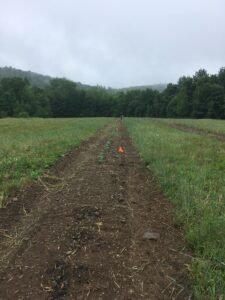
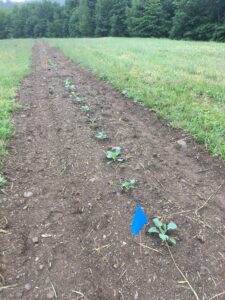
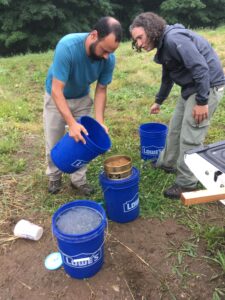
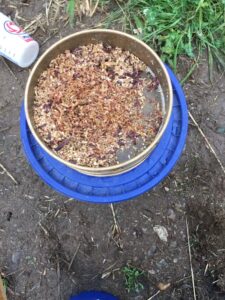
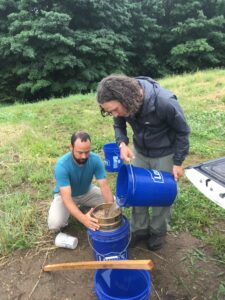
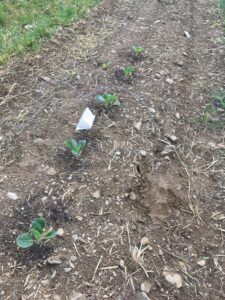
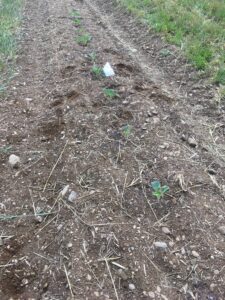
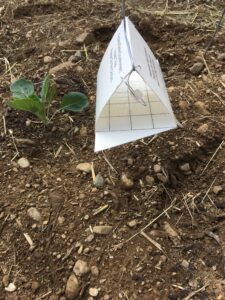
Actual methods activity:
2018:The traps were sent to the UVM lab to be checked about every two weeks for the presence of swede midge. Unfortunately, the lab was not able to make a positive identification of swede midge in the traps.
Without the pressure of SM Bti was not applied nor were the plants covered. If SM had been identified the affected planted would have been sprayed and then covered to determine whether or not Bti or other treatments reduced the presence of SM.
The trial was attempted again in 2019. In 2019 100 plants were planted using the same method as in 2018. But, bcause of the wet spring and early summer, the test plants were planted too late -past the time the swede midge usually flies. For this reason the study was not able to be carried out in 2019. The plants were planted in the same manner as in 2018. However, it was too late in the season to apply the native entomopathogenic nematodes as they need to be applied early in the season to have an impact on pests.
Without the pressure of SM Bti was not applied nor were the plants covered. If SM had been identified the affected planted would have been sprayed and then covered to determine whether or not Bti or other treatments reduced the presence of SM.
It is unclear why there was not very much SM pressure in 2018. One theory is that the dry June impacted the pupation cycle. In 2019, the study failed because of the lateness of planting, due to a wet spring, thus missing the flight of the swede midge and the window of application of the entomopathogenic nematodes in order to have any impact on incoming pests.
Because I was not able to determine the presence of SM I was not able to apply Bti nor did I cover the test crop to determine whether or not the application of nematodes worked to control SM. The results where thus inconclusive. I will attempt the study again in 2019.
In 2019, because of the wet spring and early summer, the test plants were planted too late -past the time the swede midge usually flies. For this reason the study was not able to be carried out in 2019. The plants were planted in the same manner as in 2018. However, it was too late in the season to apply the native entomopathogenic nematodes as they need to be applied early in the season to have an impact on pests. The evidence was inconclusive for both years. Additionally, there was no proven damage to the crops from swede midge. Though some plants had some odd growth habits that can be contributed to swede midge, there are other factors that can also lead to these odd growth habits such as dear, rabbit or looper damage. The damage was very minimal. It would be beneficial to see a study in an area that has a proven presence of swede midge as it seems swede midge is not a prolific around Vermont as was previously thought. Even though it has shown up in nearby towns it does not seem to have reached the higher elevation of the Worcester Mountain range where my farm is located.
Education & Outreach Activities and Participation Summary
Participation Summary:
Because the study provided no new information and didn't provide any information, we did not carry out any outreach.
Learning Outcomes
Even though I was not able to catch any swede midge in the traps, in some ways, this was a relief. It indicated that the insect is not too prevalent in my fields and that there may be years with more pressure and then years with less pressure. Though there was no evidence of the pest in the test area there was evidence of the pest late in the season in my main field where the trial was not taking place. The damage was minimal and did not affect yields or plant growth. I will continue to monitor the occurrence of swede midge as it could have a large impact on my crop.
Project Outcomes
The study failed to see swede midge damage thus the premise of study was not answered.
2018 Report
The results were inconclusive for the project in 2018 because the pest was not shown to be present. The process will be retried again in 2019 using the same methods as the 2018 project. The results will not be presented in 2019 at the NOFA conference or at the VVGA Winter Conference because results were inconclusive.
2019 Report
There was no data gathered in 2019 as the result of a wet spring, test crops were planted too late to cary out the project. Because of the timing of when the swede midge fly and when the control needs to be applied it was necessary to apply the control earlier in the growing season. Many factors impacted the process. The field where the study was being carried out has very heavy soil that takes a long time to dry out. Due to an exceptionally wet spring/early summer the fields were not ready for planting until mid June. By the time the test plot was planted it was passed the date when the control should have been applied to the field. Additionally, as was the case in 2018, there was little to no evidence of crop damage from swede midge.
Even there were no project outcomes, I hope that a farmer in an area that has greater swede midge pressure will embark on a similar study using regionally adapted (RA) entomopathogenic nematode EPN strains and Bti to try and control swede midge.